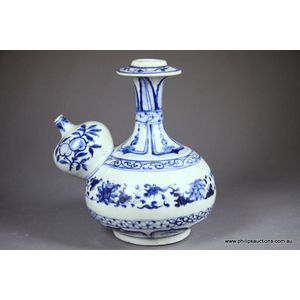18th Century Chinese Blue and White Kendi Vase
You must be a subscriber, and be logged in to view price and dealer details.
Subscribe Now to view actual auction price for this item
When you subscribe, you have the option of setting the currency in which to display prices to $Au, $US, $NZ or Stg.
- Lappet Decoration - In the context of furniture, ceramics, and oriental wares, the word "lappet" refers to a decorative motif that consists of a repeated pattern of stylized or abstracted "lappets."
A lappet in this context is a decorative element that resembles a small, hanging flap of cloth or fabric, but rather are stylized patterns that resemble the shapes and folds of lappets. They can be found on a wide range of objects, including furniture, vases, bowls, and plates.
Lappet decoration can take many different forms, but typically consists of a series of semi-circular or pointed shapes that are repeated in a continuous pattern. The shapes may be simple or highly ornate and may be arranged in a regular or irregular pattern. The design may also include other decorative elements, such as floral or foliate motifs.
Lappet decoration is often associated with Asian design traditions, and can be found on a wide range of objects from these regions, including Chinese porcelain, where lappet decoration is often used as a symbol of abundance and prosperity, and is believed to have protective and auspicious qualities. - Ming Dynasty - The Ming Dynasty was a ruling dynasty of China from 1368 to 1644. It succeeded the Yuan Dynasty and preceded the Qing Dynasty. The Ming Dynasty was established by Zhu Yuanzhang, a former Buddhist monk who became a rebel leader and eventually overthrew the Mongol Yuan Dynasty. During the Ming Dynasty, China experienced a period of relative stability and prosperity. The government was centralized and bureaucratic, with the emperor at the top of the hierarchy. The Ming Dynasty is known for its cultural achievements, including the development of porcelain, the invention of movable type printing, and the construction of the Great Wall of China.
- Qing Dynasty - The Qing Dynasty was the last imperial dynasty of China, ruling from 1644 to 1912. It was established by the Manchu people, who originated from the northeastern region of China. The Qing Dynasty was preceded by the Ming Dynasty and followed by the Republic of China.
- Arabesque - The arabesque pattern is an ornamental design that features flowing, curving lines and elaborate geometric shapes. It is inspired by the art and architecture of the Islamic world and was developed at Fontainebleu France in the mid 16th century. Its use was spread through published engravings, and it is characterized by its intricate and highly decorative nature. The arabesque pattern is created using a repetitive motif that is repeated and interwoven to create a cohesive design. It was used as a form of decoration in art, architecture, textiles, pottery, furniture and ceramics and it is often used to add a sense of grandeur and sophistication to a design. The arabesque pattern is admired for its beauty and complexity, and it continues to be used in a wide range of decorative contexts today.
This item has been included into following indexes:
Visually similar items

An antique blue and white kendi vase, Qing Dynasty, late 18th century, of typical bulbous form with a slender neck, flattened spout and mammary spout, decorated with freely executed floral and arabesque bands to the body between lappet borders and palm dec

Large decorative Chinese hexagonal blue & white porcelain vase 50 cm high

A Dutch Delft tin-glazed Chinese style vase, 19th century. 16 cm high

A Chinese porcelain vase, Kangxi mark, late 19th century, 55 cm
